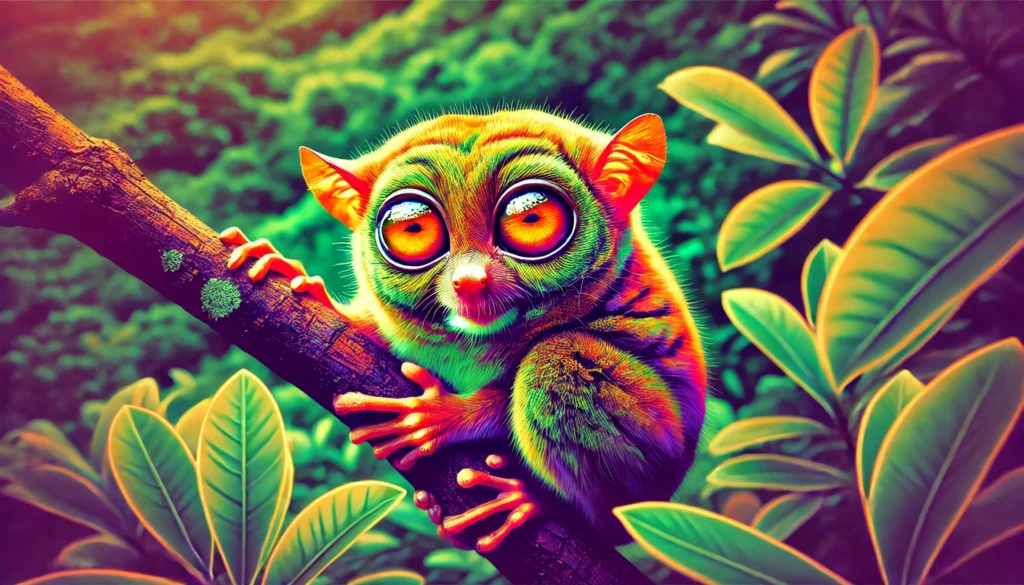The Philippines, an archipelagic nation in Southeast Asia, is renowned for its rich biodiversity. Among its many unique species, one stands out for its diminutive size and captivating appearance: the Philippine tarsier (Carlito syrichta). This remarkable creature holds the distinction of being the world’s smallest known primate, a title that has garnered significant attention from both the scientific community and wildlife enthusiasts. In this article, we will explore the fascinating world of the Philippine tarsier, delving into its physical characteristics, habitat, behavior, and conservation status. By understanding this extraordinary primate, we can better appreciate the importance of preserving the Philippines’ diverse ecosystems and the incredible creatures that call them home.
Physical Characteristics
Size and Weight
The Philippine tarsier is truly a marvel of miniaturization in the primate world. These tiny creatures typically measure between 8.5 to 16 centimeters (3.3 to 6.3 inches) in body length, with an additional tail length of 20 to 25 centimeters (7.9 to 9.8 inches). Their diminutive size is further emphasized by their incredibly light weight, ranging from just 80 to 160 grams (2.8 to 5.6 ounces). To put this into perspective, an adult tarsier weighs about the same as a small apple or a deck of playing cards. This makes them not only the smallest primate but also one of the smallest mammals in the world.
Distinctive Features
What the Philippine tarsier lacks in size, it more than makes up for in unique physical attributes. Perhaps their most striking feature is their disproportionately large eyes, which are fixed in their skull and cannot move in their sockets. These enormous eyes, each about the size of the tarsier’s brain, are adaptations for their nocturnal lifestyle, allowing them to see exceptionally well in low-light conditions. The tarsier’s head can rotate up to 180 degrees in either direction, compensating for the immobility of their eyes and giving them an almost owl-like appearance.
Another notable characteristic is their elongated hind limbs, particularly their tarsus bones, from which they derive their name. These powerful legs enable them to leap impressive distances relative to their size, often covering more than 40 times their body length in a single bound. Their fingers and toes are equipped with padded tips and claw-like nails, adaptations that allow them to grip branches securely as they move through the forest canopy.
| Feature | Description |
|---|---|
| Body Length | 8.5 – 16 cm |
| Tail Length | 20 – 25 cm |
| Weight | 80 – 160 g |
| Eye Diameter | Approximately 16 mm |
| Jumping Ability | Up to 5 meters horizontally |
Habitat and Distribution
Geographic Range
The Philippine tarsier is endemic to the Philippines, meaning it is found nowhere else in the world. Their distribution is limited to several islands in the southern part of the Philippine archipelago, primarily on the islands of Bohol, Samar, Leyte, and parts of Mindanao. This restricted range makes them particularly vulnerable to habitat loss and other environmental threats. The tarsiers’ specific habitat requirements further limit their distribution within these islands, as they are highly adapted to certain forest types and environmental conditions.
Preferred Environment
These diminutive primates are primarily arboreal, spending most of their lives in the trees of tropical rainforests. They show a strong preference for secondary growth forests, particularly areas with dense vegetation that provides ample cover and suitable perching sites. Tarsiers are often found in the understory and middle canopy layers of the forest, where they can easily move between branches and vines. They require a habitat with a good balance of open spaces for hunting and dense foliage for protection and rest. The presence of a diverse insect population is also crucial, as this forms the basis of their diet.
Behavior and Ecology
Nocturnal Lifestyle
Philippine tarsiers are strictly nocturnal, becoming active at dusk and returning to their sleeping sites just before dawn. This adaptation allows them to avoid many diurnal predators and take advantage of the abundance of nocturnal insects. During the day, they sleep clinging vertically to tree trunks or vines, often concealed within dense foliage. Their large eyes, excellent night vision, and acute hearing make them well-suited for nighttime activities, including foraging and social interactions.
Diet and Hunting
As insectivores, Philippine tarsiers primarily feed on a variety of insects, with a particular preference for moths, beetles, and crickets. They are also known to occasionally consume small vertebrates such as lizards or birds. Their hunting technique is remarkable, involving a combination of their powerful hind legs and precise hand-eye coordination. Tarsiers typically remain motionless while scanning their surroundings for prey, then leap and capture their target with their hands in mid-air. This unique hunting style, coupled with their nocturnal habits, makes them highly efficient predators despite their small size.
Social Structure
Unlike many primate species, Philippine tarsiers are generally solitary animals. They typically maintain individual territories, with males having larger ranges that may overlap with those of several females. Communication between tarsiers is primarily through vocalizations and scent marking. During the breeding season, males and females come together briefly for mating, but they do not form long-term pair bonds. Females give birth to a single offspring after a gestation period of about six months, and they are solely responsible for caring for the young.
Conservation Status and Threats
Current Status
The Philippine tarsier is currently listed as “Near Threatened” on the International Union for Conservation of Nature (IUCN) Red List. This classification indicates that while the species is not immediately at risk of extinction, it faces significant threats that could lead to a decline in population if not addressed. The primary concerns for tarsier conservation are habitat loss, fragmentation, and degradation due to human activities.
Major Threats
- Deforestation: The conversion of forests to agricultural land, urban areas, and infrastructure development is rapidly reducing the available habitat for tarsiers.
- Illegal Wildlife Trade: Despite being protected by law, tarsiers are sometimes captured for the pet trade or as tourist attractions.
- Climate Change: Alterations in temperature and rainfall patterns could affect the tarsiers’ habitat and food sources.
- Human Disturbance: Increased tourism and human encroachment into tarsier habitats can disrupt their natural behaviors and cause stress.
Conservation Efforts
Several initiatives are underway to protect the Philippine tarsier and its habitat:
- Establishment of protected areas and sanctuaries
- Educational programs to raise awareness about tarsier conservation
- Research projects to better understand tarsier ecology and behavior
- Stricter enforcement of wildlife protection laws
Conclusion
The Philippine tarsier, as the world’s smallest primate, represents a unique and fascinating example of evolutionary adaptation. Its remarkable physical characteristics, specialized behaviors, and restricted habitat make it not only a subject of scientific interest but also a symbol of the Philippines’ rich biodiversity. As we continue to learn more about these extraordinary creatures, it becomes increasingly clear that their conservation is of utmost importance. By protecting the tarsier and its forest home, we are not only preserving a singular species but also safeguarding the intricate web of life that exists within these diverse ecosystems. The future of the Philippine tarsier rests in our hands, and it is our responsibility to ensure that these tiny primates continue to thrive in their natural habitat for generations to come.
Disclaimer: While every effort has been made to ensure the accuracy of the information presented in this article, our understanding of wildlife and ecosystems is continually evolving. Readers are encouraged to consult the latest scientific literature and reputable conservation organizations for the most up-to-date information on the Philippine tarsier. If you notice any inaccuracies in this article, please report them so we can correct them promptly.




